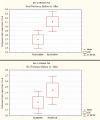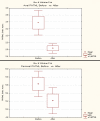Pudendal nerve decompression in perineology: a case series
- PMID: 15516268
- PMCID: PMC529451
- DOI: 10.1186/1471-2482-4-15
Pudendal nerve decompression in perineology: a case series
Abstract
Background: Perineodynia (vulvodynia, perineal pain, proctalgia), anal and urinary incontinence are the main symptoms of the pudendal canal syndrome (PCS) or entrapment of the pudendal nerve. The first aim of this study was to evaluate the effect of bilateral pudendal nerve decompression (PND) on the symptoms of the PCS, on three clinical signs (abnormal sensibility, painful Alcock's canal, painful "skin rolling test") and on two neurophysiological tests: electromyography (EMG) and pudendal nerve terminal motor latencies (PNTML). The second aim was to study the clinical value of the aforementioned clinical signs in the diagnosis of PCS.
Methods: In this retrospective analysis, the studied sample comprised 74 female patients who underwent a bilateral PND between 1995 and 2002. To accomplish the first aim, the patients sample was compared before and at least one year after surgery by means of descriptive statistics and hypothesis testing. The second aim was achieved by means of a statistical comparison between the patient's group before the operation and a control group of 82 women without any of the following signs: prolapse, anal incontinence, perineodynia, dyschesia and history of pelvi-perineal surgery.
Results: When bilateral PND was the only procedure done to treat the symptoms, the cure rates of perineodynia, anal incontinence and urinary incontinence were 8/14, 4/5 and 3/5, respectively. The frequency of the three clinical signs was significantly reduced. There was a significant reduction of anal and perineal PNTML and a significant increase of anal richness on EMG. The Odd Ratio of the three clinical signs in the diagnosis of PCS was 16,97 (95% CI = 4,68 - 61,51).
Conclusion: This study suggests that bilateral PND can treat perineodynia, anal and urinary incontinence. The three clinical signs of PCS seem to be efficient to suspect this diagnosis. There is a need for further studies to confirm these preliminary results.
Figures






Similar articles
-
Pudendal canal syndrome as a cause of vulvodynia and its treatment by pudendal nerve decompression.Eur J Obstet Gynecol Reprod Biol. 1998 Oct;80(2):215-20. doi: 10.1016/s0301-2115(98)00110-9. Eur J Obstet Gynecol Reprod Biol. 1998. PMID: 9846672
-
Endoscopic transperineal pudendal nerve decompression: operative pudendoscopy.Surg Endosc. 2018 Aug;32(8):3720-3731. doi: 10.1007/s00464-018-6239-4. Epub 2018 May 23. Surg Endosc. 2018. PMID: 29796819
-
Role of pudendal canal syndrome in the etiology of fecal incontinence in rectal prolapse.Digestion. 1997;58(5):489-93. doi: 10.1159/000201488. Digestion. 1997. PMID: 9383642
-
Pudendal neuropathy is predictive of failure following anterior overlapping sphincteroplasty.Dis Colon Rectum. 1998 Dec;41(12):1516-22. doi: 10.1007/BF02237299. Dis Colon Rectum. 1998. PMID: 9860332 Review.
-
[Pelvic floor and pregnancy].Gynecol Obstet Fertil. 2010 May;38(5):332-46. doi: 10.1016/j.gyobfe.2010.03.008. Epub 2010 Apr 24. Gynecol Obstet Fertil. 2010. PMID: 20456995 Review. French.
Cited by
-
Alternative approaches to sacral nerve stimulation.Int Urogynecol J. 2010 Dec;21(12):1559-63. doi: 10.1007/s00192-010-1282-2. Int Urogynecol J. 2010. PMID: 20972540 Review.
-
Surgical approaches for pudendal nerve entrapment: insights from a systematic review and meta-analysis.Surg Endosc. 2024 Aug;38(8):4160-4170. doi: 10.1007/s00464-024-10990-w. Epub 2024 Jun 28. Surg Endosc. 2024. PMID: 38942945
-
Post-traumatic double crush pudendal nerve entrapment syndrome after fracture of the pelvis: A case report.Acta Orthop Traumatol Turc. 2021 May;55(3):277-280. doi: 10.5152/j.aott.2021.20208. Acta Orthop Traumatol Turc. 2021. PMID: 34100371 Free PMC article.
-
Current status: new technologies for the treatment of patients with fecal incontinence.Surg Endosc. 2014 Aug;28(8):2277-301. doi: 10.1007/s00464-014-3464-3. Epub 2014 Mar 8. Surg Endosc. 2014. PMID: 24609699 Review.
-
A minimally invasive, endoscopic transgluteal procedure for pudendal nerve and inferior cluneal nerve neurolysis in case of entrapment: 3- and 6-month results. The ENTRAMI technique for neurolysis.Int J Colorectal Dis. 2020 Feb;35(2):361-364. doi: 10.1007/s00384-019-03480-2. Epub 2019 Dec 11. Int J Colorectal Dis. 2020. PMID: 31828369
References
-
- Beco J, de Bisschop G, Dijkstra R, Nelissen G, Mouchel J. [Perineology...reaching equilibrium and preserving it?] J Gynecol Obstet Biol Reprod (Paris) 1999;28:855–856. - PubMed
-
- Beco J, Mouchel J. Perineology: a new area. Urogynaecologia International Journal. 2003;17:79–86.
-
- Juenemann KP, Lue TF, Schmidt RA, Tanagho EA. Clinical significance of sacral and pudendal nerve anatomy. J Urol. 1988;139:74–80. - PubMed
-
- Shafik A. Pudendal canal syndrome. Description of a new syndrome and its treatment. Report of 7 cases. Coloproctology. 1991;13:102–110.
MeSH terms
LinkOut - more resources
Full Text Sources
Medical

